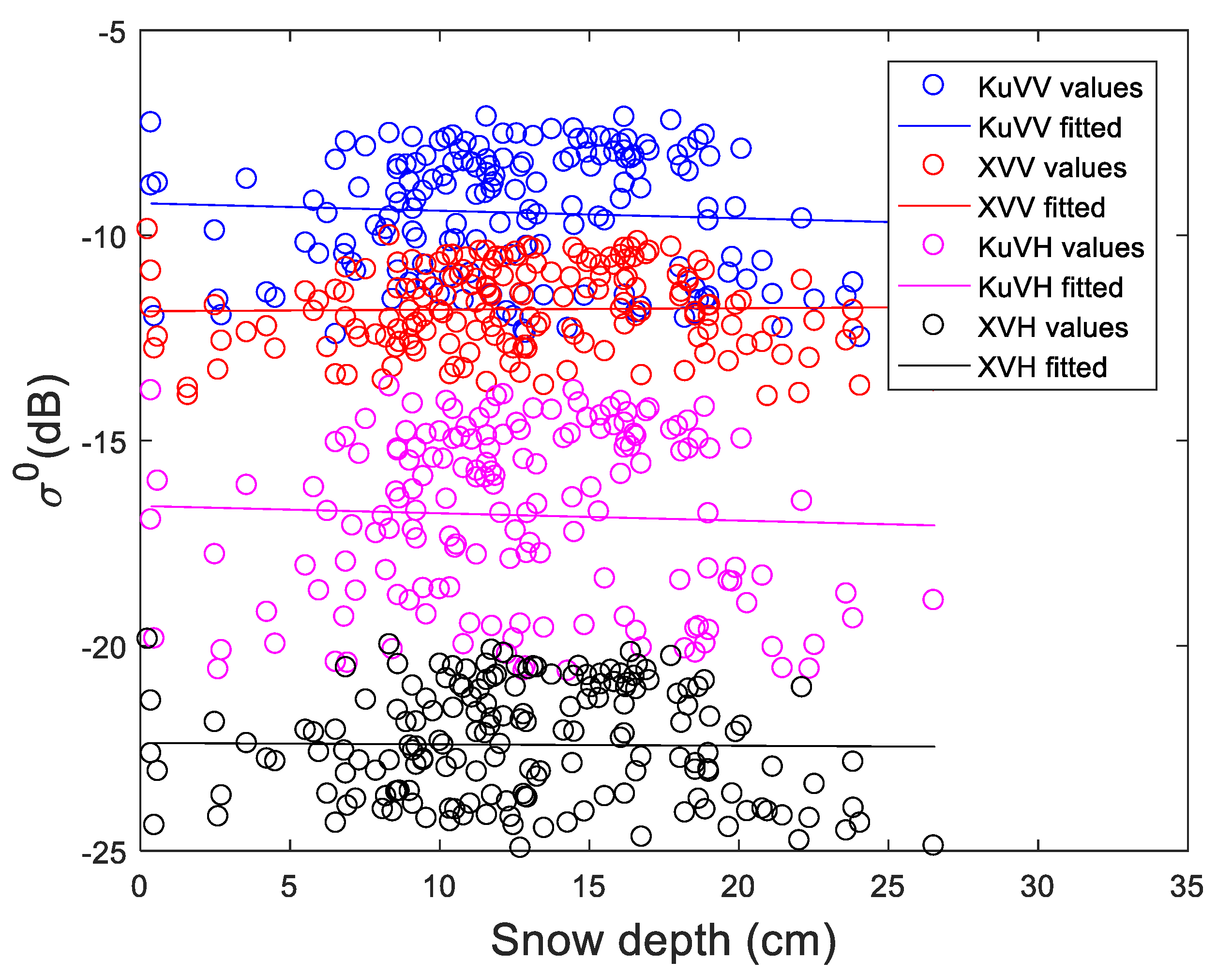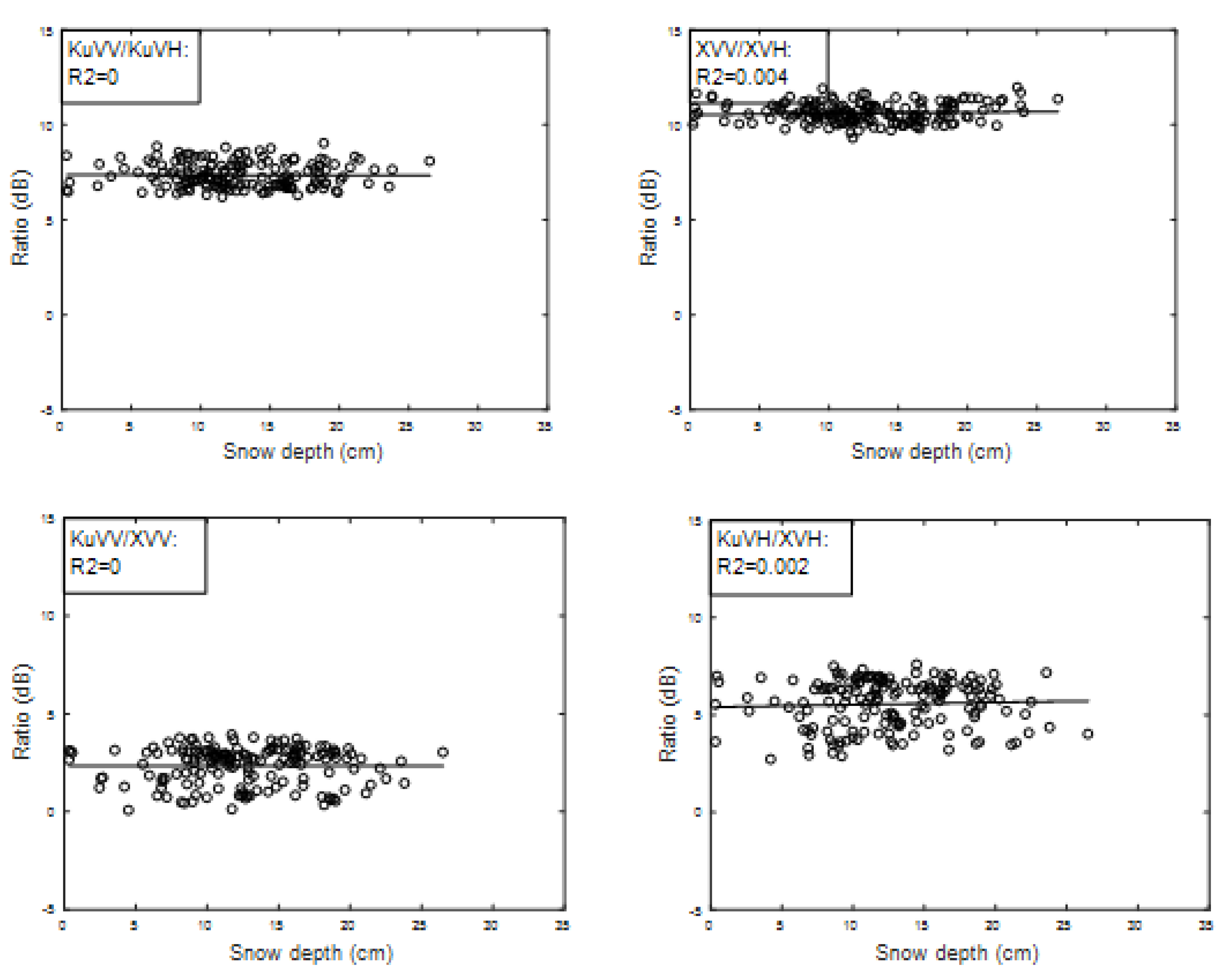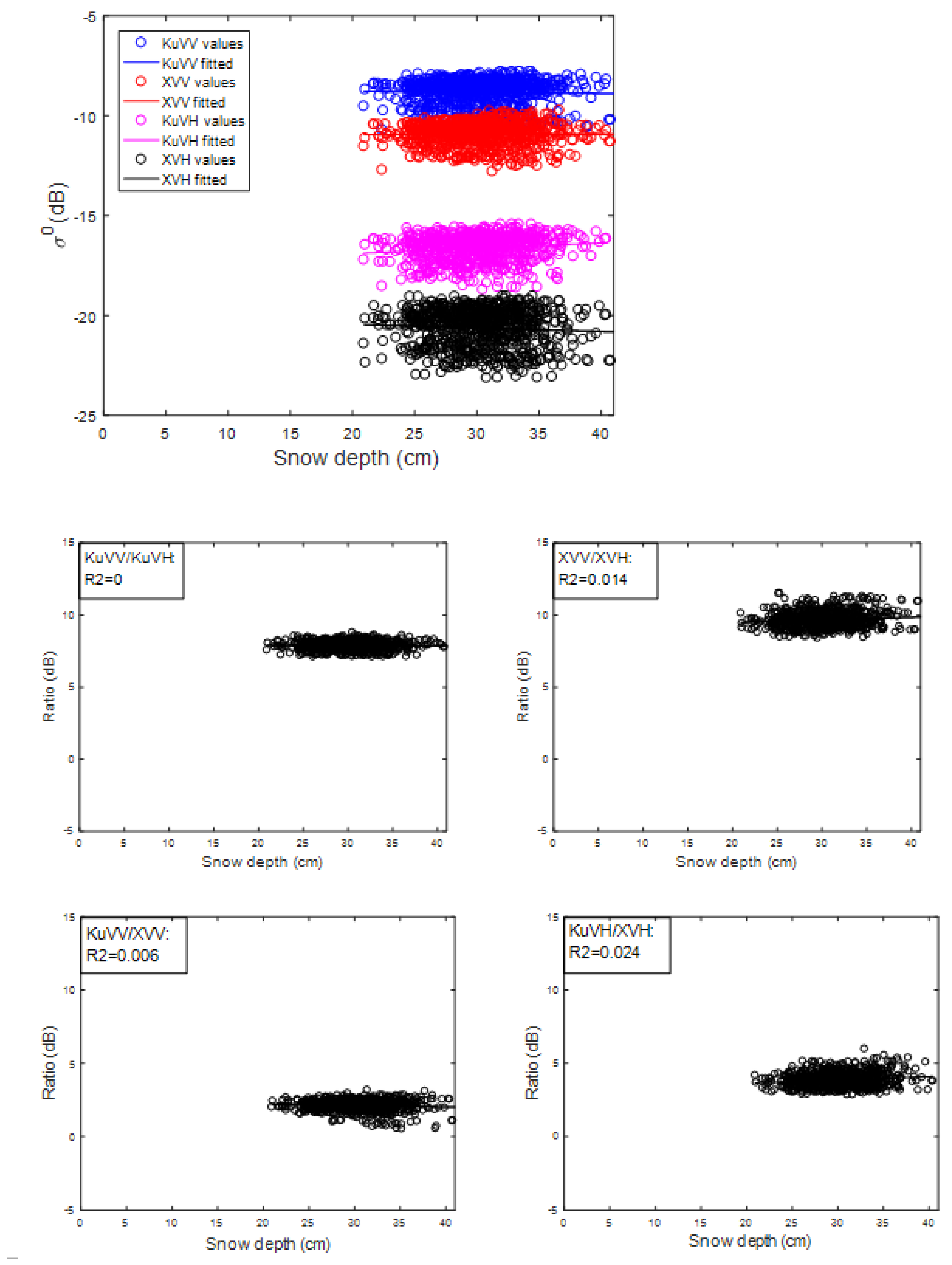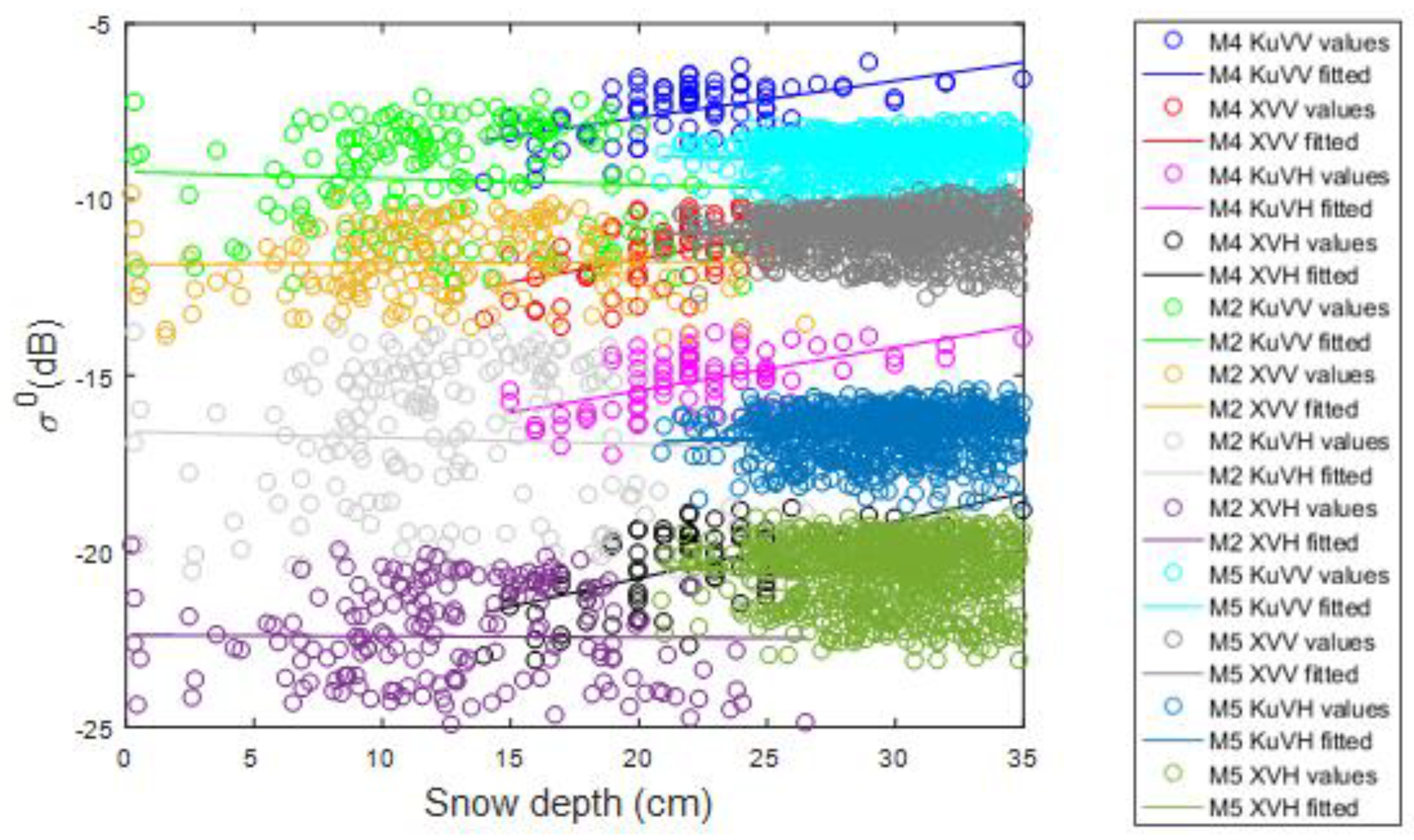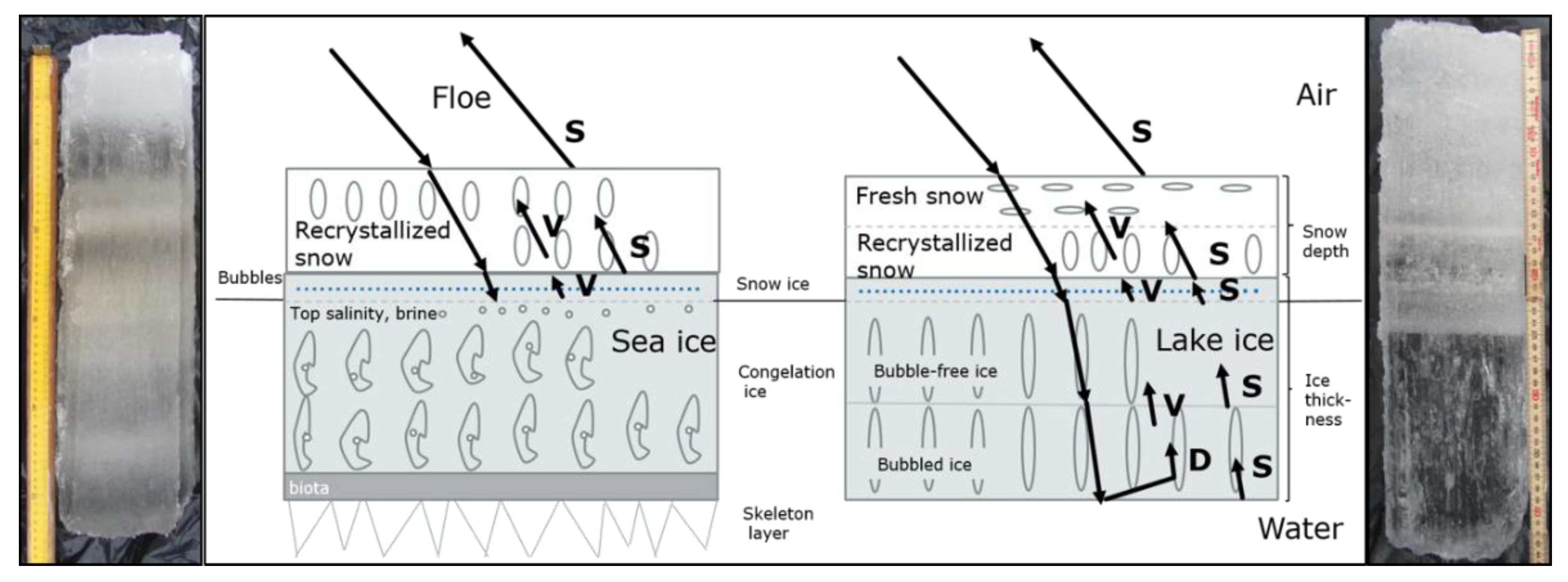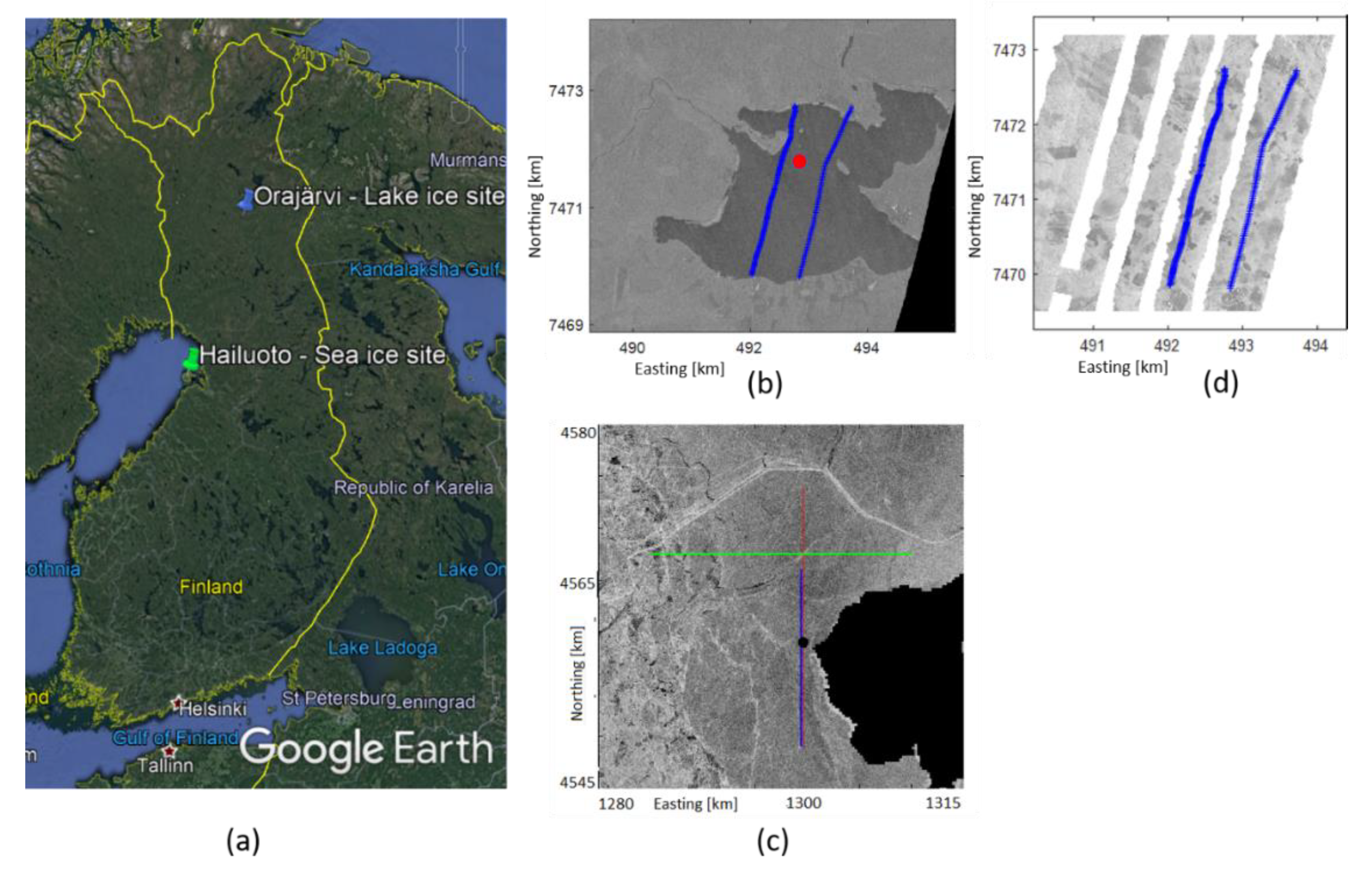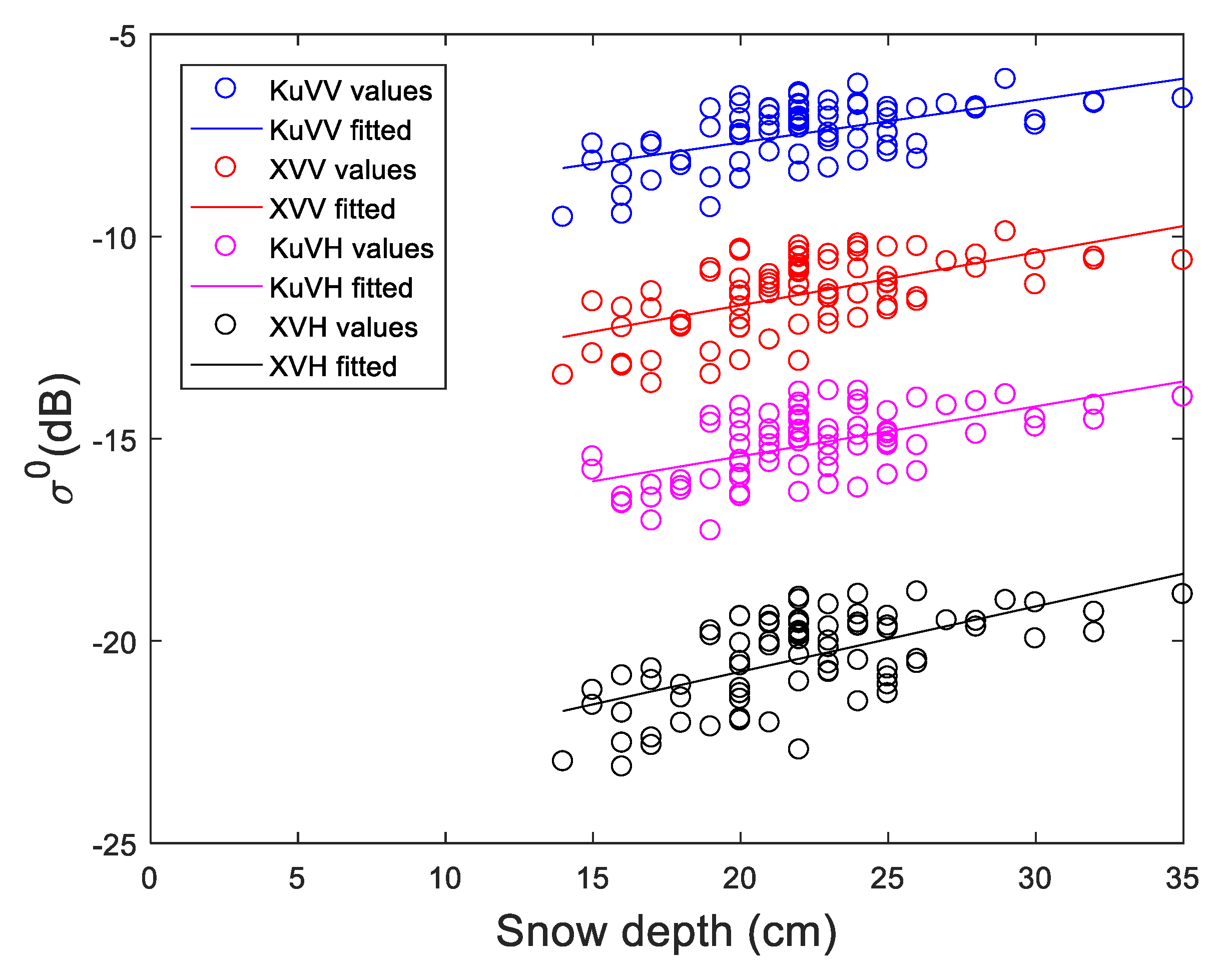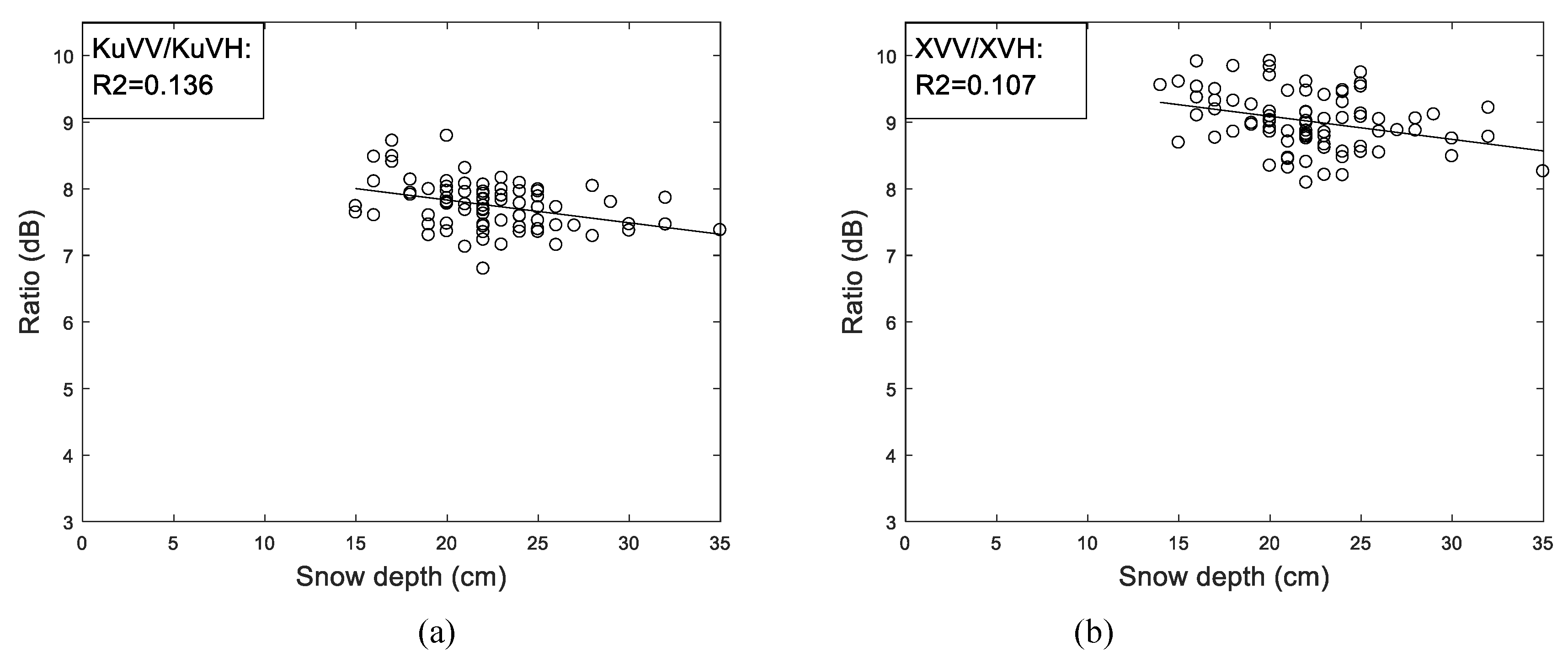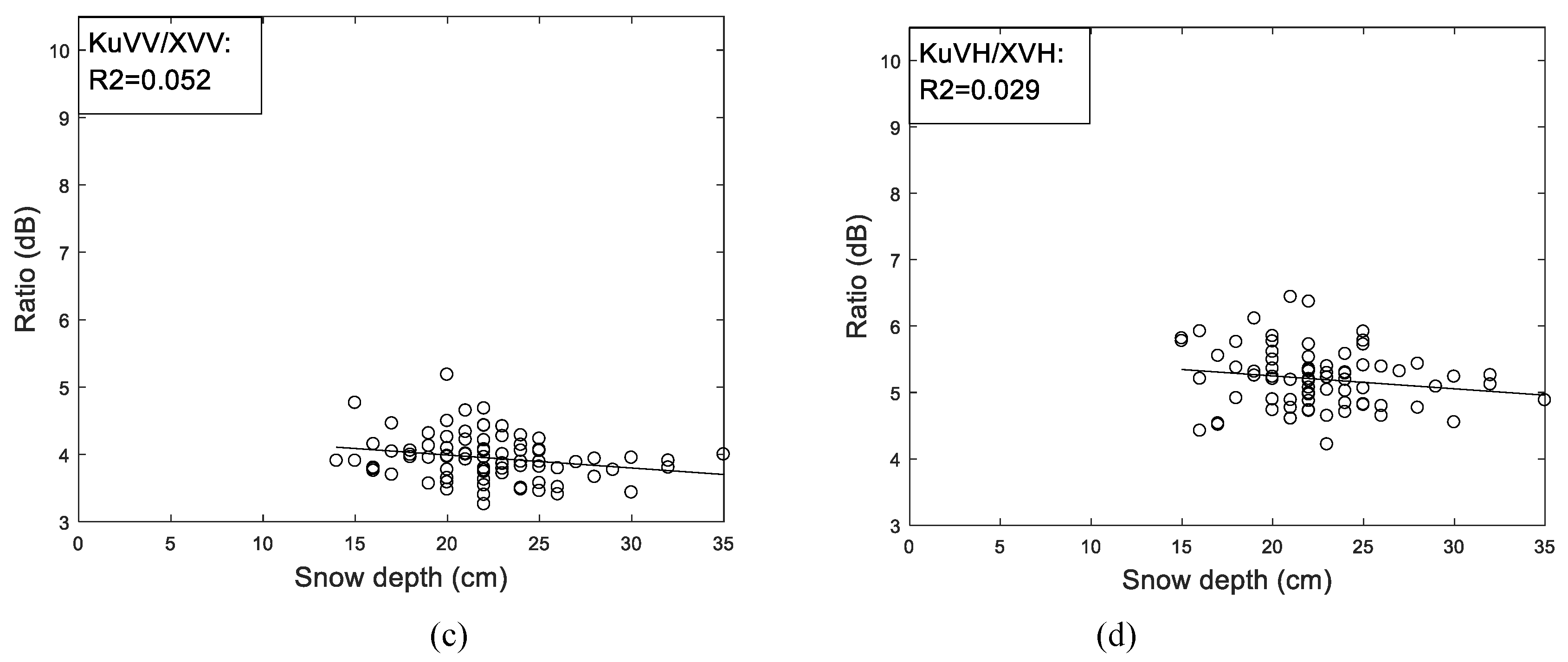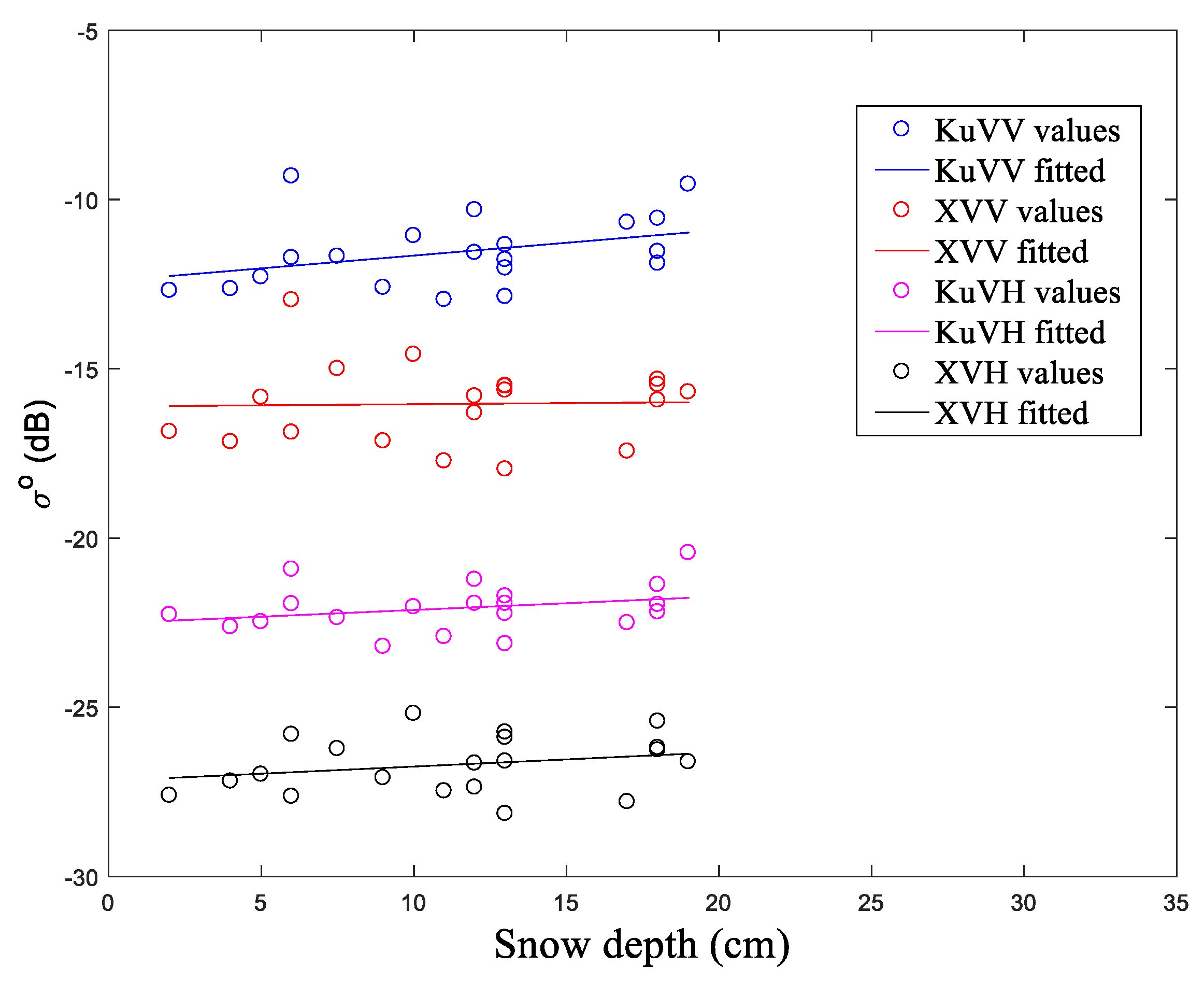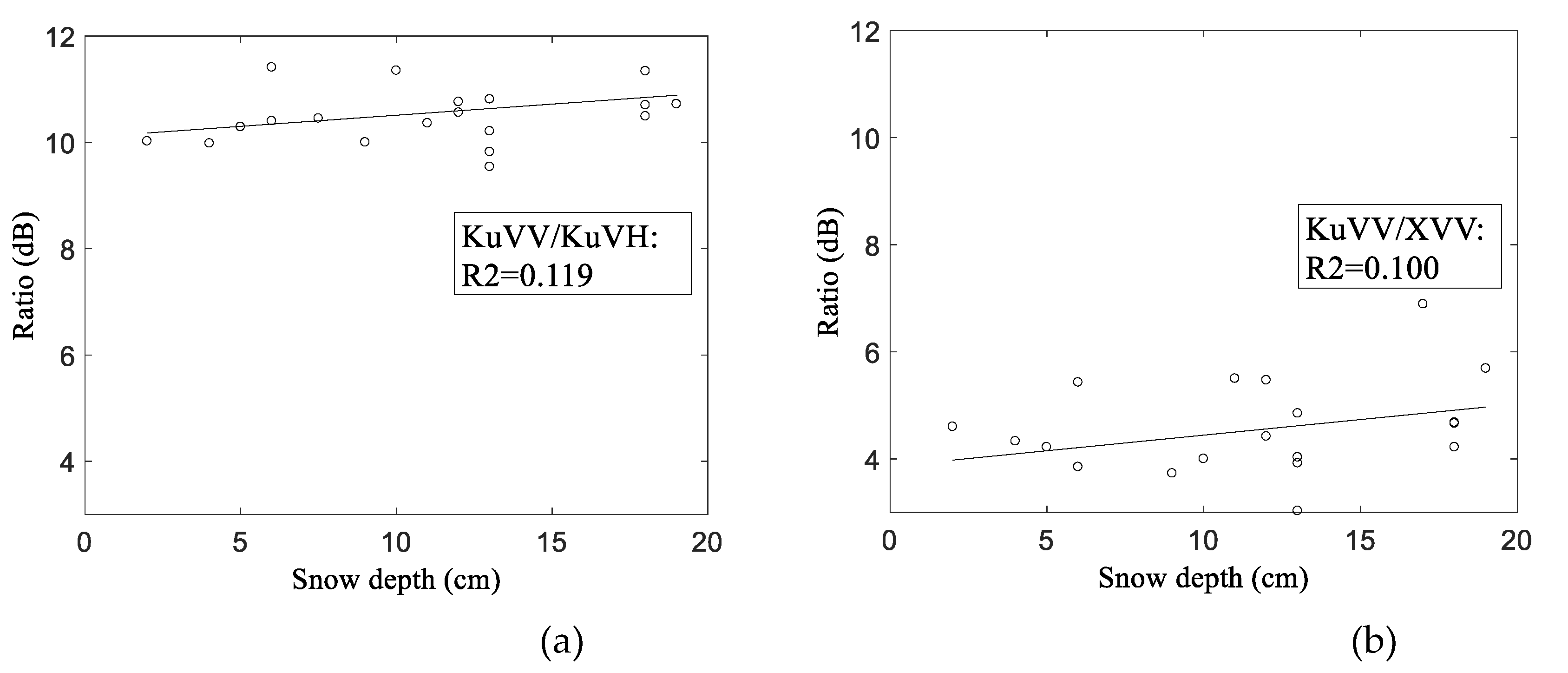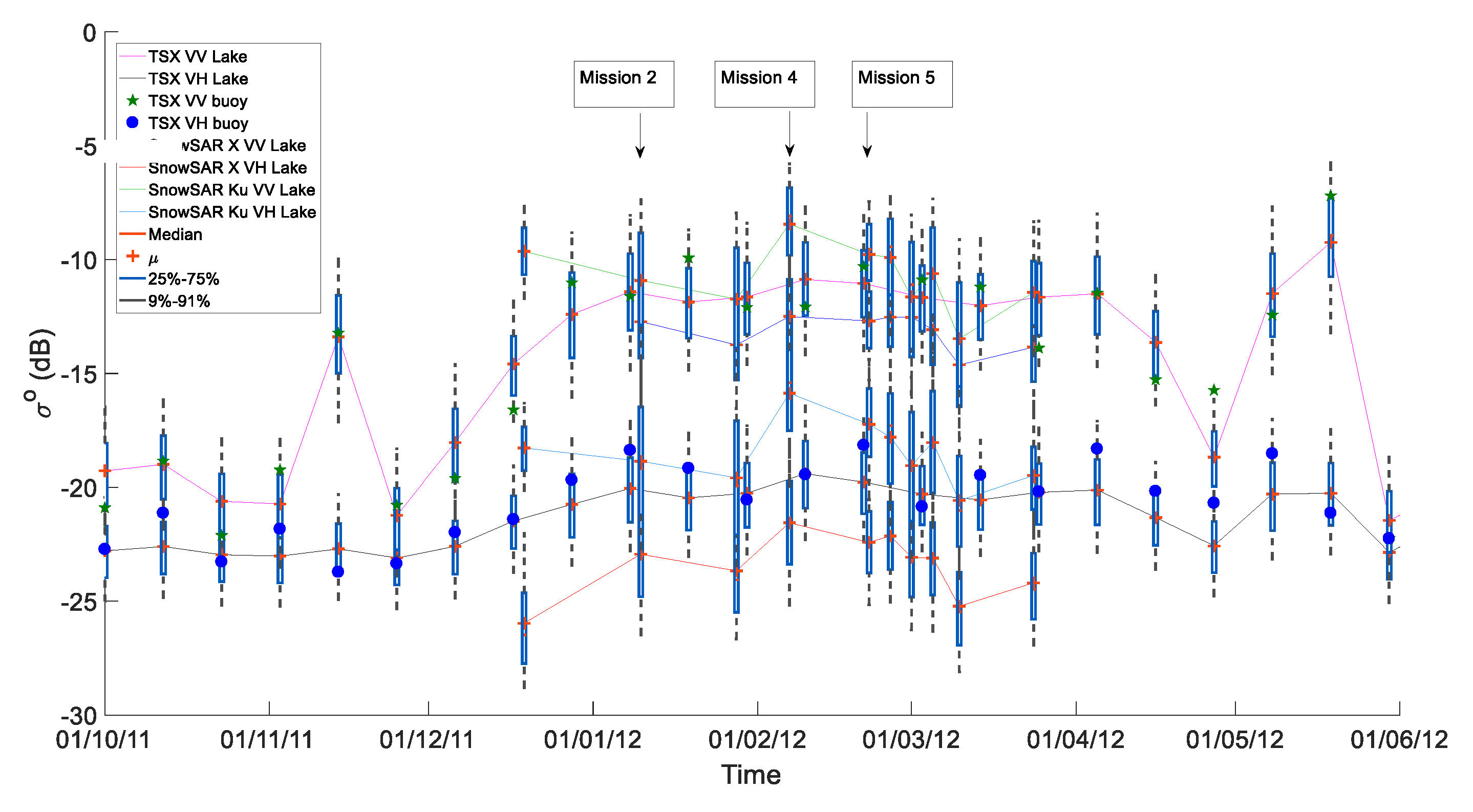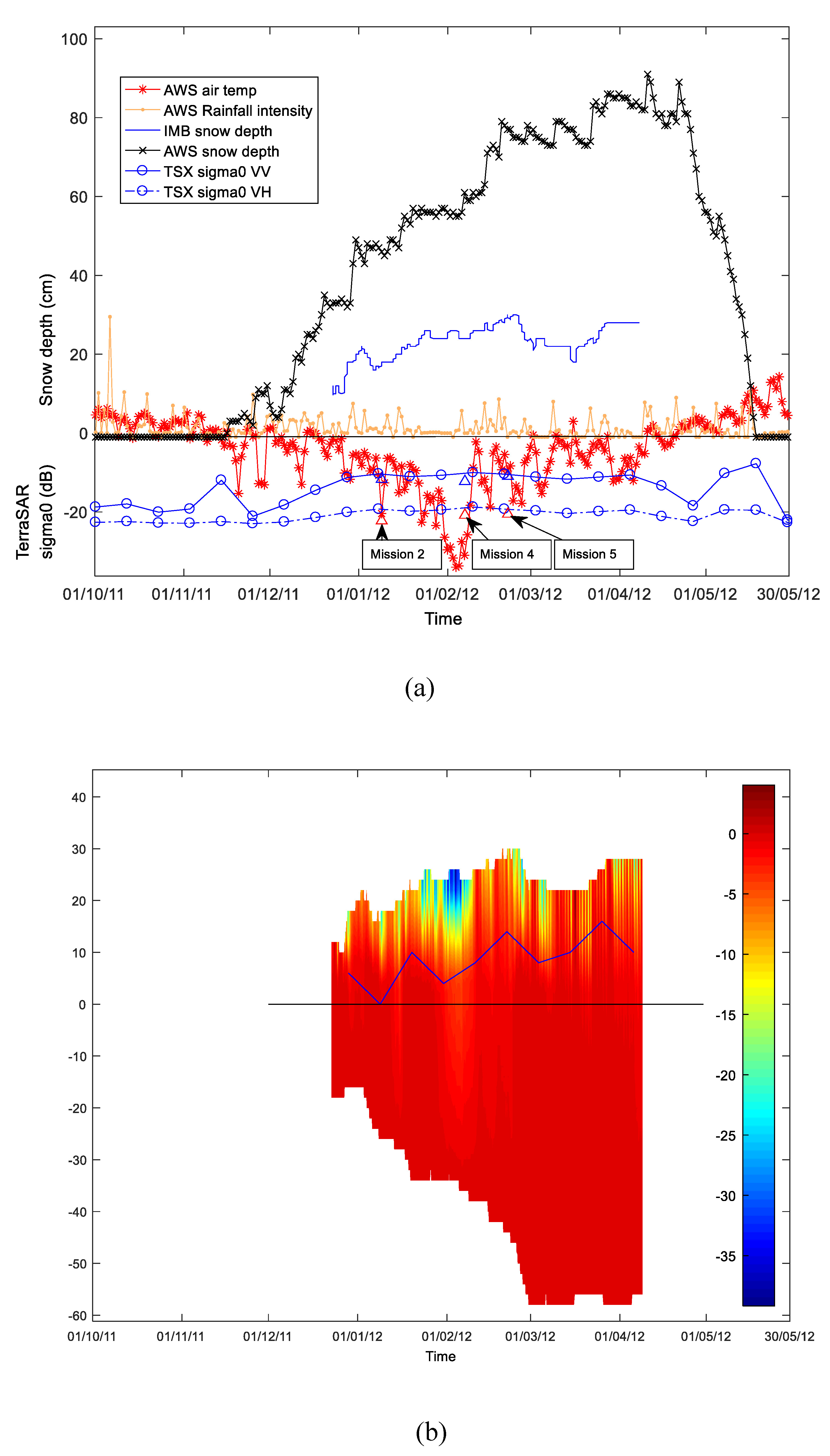1. Introduction
Snow cover has a major impact on the evolution of ice cover both in lake and sea environments [
1,
2]. During the freezing season, snow cover introduces a strong insulation effect that reduces ice growth at the ice/water interface. When the ice is thin, a heavy snow load on ice can contribute to the total ice mass by widespread surface flooding that forms slush and later snow-ice [
2]. During the melting season, snow meltwater refreezing at the snow/ice interface leads to forming of superimposed ice [
2]. Additionally, the high albedo of snow reflects a large part of solar radiation, which alters the surface energy balance and affects the amount of energy being reflected, absorbed, and transmitted through the ice and the underlying water. During the melt season, the ice starts to melt faster after snow melt-off [
3].
Accurate snow depth data is needed to model the heat, momentum, and gas fluxes between the ocean, ice, and atmosphere [
3]. Furthermore, snow on ice is a significant source of uncertainty in sea ice thickness estimation based on radar and laser altimetry (e.g. CryoSat-2 and ICESat-2) [
4,
5].
Snow depth on sea and lake ice needs to be observed with spatial and temporal resolutions required by numerical weather prediction models and operational monitoring of the state of lake and ocean conditions, e.g., daily with 10 km resolution. While accurate data can be obtained with in-situ observations, these rarely cover a large spatial extent at any one time. Airborne measurements of snow depth with an airborne Frequency-Modulated Continuous-Wave (FMCW) radar [
6,
7,
8] cover a much larger area than in-situ measurements in a short time but are too expensive for continuous monitoring. Improved ultra wideband radars (UWBs) have also been installed in airplanes to find out the snow depth on the Arctic sea ice [
9]. In addition, recently unmanned aerial vehicles (UAVs), known as drones, have been used to retrieve snow depth information on sea ice [
10]. One solution is to use satellite microwave remote sensing data for the snow depth estimation on lake and sea ice [
11,
12].
There are some lake and sea ice properties, which have a large influence on the usability of microwave remote sensing instruments to obtain snow and ice information. In the case of lake ice, the water, ice and snow are non-saline, compared to sea ice and its snow cover, which can have a variable degree of salinity. The salinity has a large effect on the relative permittivity of snow and ice, and thus, on the penetration depth of electromagnetic waves. The relative permittivity
is a complex parameter that characterizes the dielectric properties of media, where
is the dielectric constant and
is the dielectric loss factor. The penetration depth is
, where
and
is the wave number in free space.
for sea ice is typically higher than for lake ice due to salinity inclusions, reducing the penetration depth greatly, when the frequency is less than 10 GHz [
13]. For lake ice the penetration depth is larger, which results in also high frequency microwave (e.g. 36 and 89 GHz) data to carry snow and ice information from deep in the ice media. Ice dynamics, caused by winds and waves, are more substantial in the oceans than in the lakes, leading to drifting of sea ice, ice deformation and variable ice concentration, which yields more variable sensor signatures for sea ice than for lake ice. Over both lake and sea ice close to the coast the usage of the microwave radiometer (MR) data (resolution 5 to 25 km) is also limited due to mixed-pixel effects (i.e. mixture of land and ice signatures). Finally, the size of most lakes limits the feasibility of using the MR data in estimation of snow depth and other ice and snow properties to only the largest lakes [
14].
In this study we investigate relationships between the snow depth on lake and sea ice and X- and Ku-band backscattering coefficients (
) from synthetic aperture radar (SAR) imagery. The goal is to see whether snow depth estimation is possible with the
data. Retrieval of sea and lake ice properties from X- and Ku-band backscattering was one of the secondary goals of the Cold Regions Hydrology High-Resolution Observatory (CoReH2O), a mission proposal in the ESA Earth Explorer program [
15]. In the following we discuss about previous studies on snow depth and snow water equivalent (SWE) estimation on sea ice and lake ice using the MR and SAR data. We also discuss how sea ice and lake ice properties and
are typically related. Finally, we present an overview of our study in
Section 1.1.
Operational methods for snow depth (or SWE) estimation over sea ice with the MR data have been developed in many studies, e.g., [
12,
16,
17]. Currently, the MR based snow depth data is accurate only over smooth first-year ice (FYI) [
7,
16,
18,
19]. Over deformed FYI or multiyear ice (MYI), snow depth is substantially underestimated [
19]. The operational algorithms are typically based on the 19 GHz (K-band) and 37 GHz (Ka-band) brightness temperature (
) data and snow
signature difference between these two frequencies. Snow depth estimation accuracy is also in general degraded by mixture of various ice types typically present within large MR footprints. Snow depth on sea ice have been also investigated by using numerical one-dimensional snow and sea ice thermodynamic models, e.g. [
20,
21]. Recently, snow depth on sea ice has been estimated also by using satellite altimetry [
22,
23,
24], for example, by using dual-frequency radar freeboards or coincident satellite radar and lidar altimetry. In the coming Copernicus Polar Ice and Snow topography Altimeter (CRISTAL) high-priority mission, a dual-frequency satellite altimeter will provide information about snow depth on sea ice and will also help to discriminate between the ice and snow interfaces [
25]. Like for sea ice also for lake ice many studies on snow and ice properties and their temporal changes have been conducted using thermodynamic models, e.g. [
26,
27], and a Snow Microwave Radiative Transfer (SMRT) model [
28]. Lake ice thickness has been studied using the satellite altimeter, moderate resolution imaging spectroradiometer (MODIS) and MR data, and in addition phenology studies have been conducted [
14,
29,
30].
Products for the snow depth over Arctic sea ice retrieved from altimeter and MR satellite measurements as well as from reanalysis have been compared recently [
31]. They highlighted the need for more targeted Arctic surveys with different spatial and temporal scales to be able to make more systematic comparison of airborne, in situ and satellite based observations. In a recent study, the CryoSat-2 altimeter measurements have been combined with passive microwave (AMSR) and infrared (AVHRR) measurements to obtain snow depth on sea ice [
31].
In order to obtain information of snow depth at fine spatial scales (~0.1-1km), the use of SAR data, that has much better spatial resolution than MRs, has been investigated in some case studies, e.g. [
32,
33,
34]. These have not yet resulted in any operational applications. So far, studies have been conducted mainly with C-band SAR sensors due to availability of large amount of SAR imagery. However, theoretical investigations indicate that the effect of snow cover on sea ice to radar backscattering at the X- and Ku-band can be more pronounced than at C-band [
35,
36,
37,
38].
There are several factors that influence the of a target – both the parameters of the SAR sensor and the properties of the target itself. Examples of the former are wavelength (frequency), polarization, incidence angle, and resolution, and of the latter are surface roughness (compared to the SAR wavelength), volume fraction, size, and shape of the scatterers in the media, and relative permittivities of the scatterers and the host media. In case of snow-covered lake and sea ice, snow depth, snow density, snow microstructure (e.g. crystal size), amount of liquid water in the snowpack and surface roughness contribute to the measured . These snow properties vary spatially and temporally as a result of snow transport by wind, melt-refreeze events, and snow deposition and metamorphism.
Different backscattering sources contributing to the measured
for sea ice and lake ice are shown in
Figure 1. These include surface scattering at the air-snow, snow-ice and ice-water interfaces, as well as scattering in the ice and snow volumes [
39,
40]. Typically, dry snow cover on ice increases
compared to the case of bare ice through the increased backscattering in the snow volume [
40,
41]. For sea ice, the total
typically consists of surface scattering from the snow surface, volume scattering from the snow layer, surface scattering from the ice surface and scattering from the air bubbles and brine pockets in the ice medium. For lake ice, there is more volume scattering from the lower layers of the ice, surface scattering from internal layers in the ice, scattering from the ice-water surface and double-bounce scattering from the bottom bubbled ice layer are included as well [
42,
43].
In recent studies, the scattering caused by the roughness of ice/water interface has been found to be the primary contribution to the total scattering over lake ice and not the double bounce from air bubbles, as has been assumed previously [
29,
44]
. In the case of wet snow, the high dielectric contrast between air and wet snow causes scattering from the snow surface to become a dominant factor [
40]. In case of rough ice, the effect of dry snow cover can be negligible, with the ice surface scattering being a dominating factor, especially in lower frequencies, e.g. at C-band [
35,
40].
An investigation using C-band SAR indicated that changes of the dielectric properties of snow cover due to an air temperature change are detectable in
for smooth thick landfast FYI [
32]. This allowed to detect SWE changes using SAR image pairs, one acquired in cold (~-26 °C) and one in moderately cold (~-14 °C) conditions. Snow cover affects the temperature of the upper surface of the ice, which affects the brine volume, dielectric properties and scattering characteristics within the snow volume [
32]. In higher temperatures, the snow grains become brine wetted and produce volume scattering.
It has been found that even a thin snow cover (2 cm) increases
at an oblique incidence angle at C- and Ku-bands [
41]. However, increasing dry snow depth did not further influence
[
41]. On contrary to cold conditions (-7.9 °C), no relationship between various radar polarimetric parameters and snow depth was found under warmer conditions (-0.4 °C) [
34]. The results suggested that snow depth estimation based on snow thermodynamics at warm conditions is not possible, whereas during cold winter conditions (<-10 °C), snow depth could be retrieved from SAR data. In general, for sea ice
at the C-band, volume or mixed scattering components increase with increasing snow depth, most likely due to brine-wetted snow layers at the ice-snow interface [
34].
Investigations using higher frequencies, such as X-band, show that the effect of snow cover on
is large, especially in the case of FYI [
35]. For lake ice, Ku-band
, measured with ground-based scatterometers, has been found to be sensitive to the snowpack, whereas X-band
was found to be largely insensitive [
45]. Based on the scatterometer measurements, as the wavelength is shorter at Ku-band (17.4 mm) compared to X-band (31 mm), the interaction with initial tubular bubble formation (see
Figure 1) close to the ice/water interface and with grains within the snowpack above the ice may be increased [
46].
SAR imagery has been also used for lake ice classification (open water and various ice types, ice break-up) and to detect floating and bedfast lake ice regimes in the Arctic, e.g. [
47,
48,
49,
50]. In addition, using polarimetric decomposition in order to understand scattering processes in freshwater ice has been investigated recently [
51].
Finally, a comprehensive review of the remote sensing of lake and river ice presented nearly ten years ago by Duguay et al. [
52] stated that to their knowledge no operational method has yet been developed for estimating snow depth or SWE on lake ice. To our knowledge this is still the case.
1.1. Overview of the Study
The first objective in this paper is to investigate relationships between the snow depth on lake and sea ice and
at the X- and Ku-bands. We use SAR and in-situ data collected in Finland, between February and March 2012, during Phase A studies of the CoReH2O mission [
15]. The X- and Ku-band SAR data was acquired with ESA’s airborne SnowSAR sensor [
53]. Lake ice SAR and in-situ data were acquired on Lake Orajärvi, in Northern Finland, and sea ice data on smooth landfast ice in the Bay of Bothnia of the Baltic Sea, see
Figure 2. The acquired airborne SAR data is compared with in-situ measurements collected along tracks on lake ice and sea ice. In particular, the relationships between spatial variability of snow depth and multi-channel
signatures and various
polarisation ratios are studied. The second objective is to investigate relationships between temporal evolution of snow depth and
. This study is conducted using time series of TerraSAR-X (TSX) Stripmap Mode images (VV- i.e. vertical-vertical- and VH- i.e. vertical-horizontal- polarisations) acquired over the lake ice site in 2011-12. During this time an ice mass balance buoy (IMB) collected continuous snow and ice thickness data.
We note that although there are many other snow and ice properties besides snow depth contributing to the measured , such as snow grain size and the size, shape and density of ice air inclusions (i.e. bubbles). However, here we investigate empirically the relationship between snow depth and . This is due to interest to see if a simple value or ratio based snow depth estimation is possible with the acquired X- and Ku-band data. We know from past studies that grain size, bubbles, etc., need to be accounted for in order to e.g. accurately model the backscattering response; however, from the point of view of operational applications, acquiring any quantitative information on either one is very challenging, especially at high spatial resolution.
This paper is organized as follows. Materials and methods used in this study are first presented in
Section 2. The results of our study are presented in
Section 3, starting with an overview of snow and ice properties in the sea ice and lake ice sites, and followed by a quantitative analysis of multi-channel SnowSAR
data against snow depth on lake and sea ice. Furthermore, a qualitative analysis of TSX imagery for lake ice and the time series of TSX
over lake ice are presented. In
Section 4 (Discussion), we compare our results to previous work, and finally, we give our conclusions in
Section 5.
3. Results
Here we present first an overview of snow and ice properties in the sea ice and lake ice sites. Next, relationships between the SnowSAR data and the snow depth on lake ice and sea ice are investigated and quantified. This is followed by qualitative analysis of the TSX imagery for lake ice, and analysis of the lake ice TSX timeseries.
3.1. Overview of Snow and Ice Properties in the Sea Ice and Lake ice Sites
Various snow and ice properties: snow depth, ice thickness, ice salinity, SWE and snow density, are listed in
Table 2 for the sea ice and lake ice sites.
For the sea ice site, although the snow depth exhibited large spatial variability (compared to the mean), the average snow pack was relatively thin, only 11 cm. The snow and ice thickness in the sea ice site were within a typical range for the landfast ice in the Bay of Bothnia in early March [
59]. The variation of snow density was within expected values for settled snow (0.2 to 0.3 g/cm
3) and wind packed snow (0.35 to 0.4 g/cm
3 ) [
60]. Based on the in-situ observations, the structure of the snowpack was fairly homogeneous. There was a ca. 3 cm layer of hard crust on top with a layer of fine grained dry snow underneath. The snow was not frozen to the ice surface, but loose. The two sampled ice cores showed vertical salinity variations between 0.2 and 1.0 ppt which are typical low salinity values for sea ice in the Bay of Bothnia [
55]. According to the AWS observations a few kilometers from the measurement line, the air temperature (
) was on average -3.7 °C during the SnowSAR data acquisition over the sea ice site on 8 March, and from -6.1 °C to -2.7 °C during the in-situ measurement campaign 7 - 8 March (-8 °C during the night between). The snow pack on the sea ice was qualitatively observed to be dry (i.e. volumetric wetness close to 0%).
For the lake ice site, in the mission 2, snow depth varied between 0.4 and 27 cm. According to the AWS data was about -24 °C during the SnowSAR data acquisition on 9 January (daily mean -20.4 °C) and during the in-situ measurement campaign on 10 January the daily mean was -12.6 °C. Based on the snow pit measurements on 8 December 2011 (the closest one for the mission 2), snow depth was 7 cm, the temperature of snow was between 0.4 (bottom) and -1.3 °C (top), the density was between 0.13 and 0.15 g/cm3, grain size approximately between 0.5 and 1.5 mm, and grain type was precipitation particles/needle on top and rounded grains/irregular on bottom part of the snow cover.
For the lake ice site, in the mission 4, snow depth varied between 12 and 35 cm.
was about -29 °C during the SnowSAR data acquisition on 7 February (daily mean -31 °C), and during the in-situ measurement campaign on 8 February the daily mean
was -26 °C. Based on the snow pit measurements on 9 February, snow depth was 20 cm, the temperature of snow was between -1.9 (bottom) and -17.4 °C (top), the density was between 0.05 and 0.21 g/cm3, moisture between 0.4 and 1.0 %, grain size approximately between 0.8 and 2.5 mm, and grain type was precipitation particles/stellars/dendrites/irregular on top and hollow cups on bottom part of the snow cover. The measured snow density values are typical for the site [
61].
For the mission 5 snow depth varied between 21 and 41 cm. was about -6 °C during the SnowSAR data acquisition on 22 February, and during the in-situ measurement campaign on 22 February the daily mean was -9.6 °C. The snow pit measurements on 22 February showed snow depth of 30 cm. The temperature of snow was between -0.3 (bottom) and -13.9 °C (top), the density was between 0.14 and 0.24 g/cm3, moisture 1 %, grain size approximately between 0.5 and 2 mm, and grain type was partly decomposed precipitation particles on top and hollow cups on bottom part of the snow cover.
’s during the SnowSAR flights and in situ data collection had the largest difference in the mission 2, where the former was approximately -20.4 °C and the latter -12.6 °C. For the mission 4, ’s were -31 and -26 °C (for the track 1), respectively. The SnowSAR and in situ data for the mission 5 were acquired on the same day, thus ’s were quite similar.
In the IMB time series from Dec 2011 to Apr 2012 the snow depth varied between 10 and 30 cm. The ice thickness varied between 16 and 58 cm.
3.2. SnowSAR Data versus Snow Depth on Lake Ice
The relation between the mean
and the snow depth for the two measurement lines (track1 and track2 in the mission 4) was investigated separately.
Figure 3 shows scatterplots between the snow depth and the mean
at the four SnowSAR channels.
Figure 4 has scatterplots between the SnowSAR channel ratios and snow depth for the track1. Linear regression fits to the data are also depicted in the figures. Statistics describing the linear regression between the
channels or channel ratios and the snow depth for the track1, track2 and for the both tracks combined are presented in
Table 2.
For the track1, the coefficient of determination (R2) between the KuVV and snow depth was modest, 0.33, but the p-value for the regression was <0.001. For the track2, R2 in the case of the KuVV was only 0.19. In general, the results for the track2 show R2’s than the track1, possibly because the track2 exhibited (by visual analysis of the SAR imagery) a wider variety of different lake ice types (mainly refrozen ice from cracks and leads).
The best sensitivity to the snow depth with all channels, in terms of R2, was found for the XVH (R2=0.36 for the track1 and R2=0.24 for the track2), and within all channel ratios for the KuVV/KuVH ratio (R2=0.14 for the track1, R2=0.09 for the track2). For the combined tracks, the best sensitivity was again for the XVH (R2=0.29), but now for the KuVH/XVH ratio (R2=0.08). At XVH, was found to increase more in relation to the snow depth (0.16 dB/cm for the track1 and track2, and for the combined tracks) than at other channels.
Table 3.
Statistics of the linear regression between the SnowSAR backscattering coefficient data and the in-situ snow depth data for the mission 4 track1, track2 and both tracks combined in the lake ice site.
Table 3.
Statistics of the linear regression between the SnowSAR backscattering coefficient data and the in-situ snow depth data for the mission 4 track1, track2 and both tracks combined in the lake ice site.
| Lake Track1 |
|
| |
slope term [dB/cm] |
AVERAGE [dB] |
R2 |
p-value |
| XVV |
0.13 |
-11.3 |
0.34 |
< 0.001 |
| XVH |
0.16 |
-20.3 |
0.36 |
< 0.001 |
| KuVV |
0.11 |
-7.4 |
0.33 |
< 0.001 |
| KuVH |
0.12 |
-15.1 |
0.33 |
< 0.001 |
| KuVV/KuVH |
-0.03 |
7.8 |
0.14 |
< 0.001 |
| XVV/XVH |
-0.03 |
9.0 |
0.11 |
0.003 |
| KuVV/XVV |
-0.02 |
4.0 |
0.05 |
0.042 |
| KuVH/XVH |
-0.02 |
5.2 |
0.03 |
0.138 |
| Lake Track2 |
|
| |
slope term [dB/cm] |
AVERAGE [dB] |
R2 |
p-value |
| XVV |
0.08 |
-12.7 |
0.15 |
< 0.001 |
| XVH |
0.16 |
-21.1 |
0.24 |
< 0.001 |
| KuVV |
0.08 |
-8.5 |
0.19 |
< 0.001 |
| KuVH |
0.12 |
-14.3 |
0.22 |
< 0.001 |
| KuVV/KuVH |
-0.04 |
6.0 |
0.09 |
< 0.001 |
| XVV/XVH |
-0.07 |
8.6 |
0.07 |
< 0.001 |
| KuVV/XVV |
-0.01 |
4.3 |
0.01 |
0.142 |
| KuVH/XVH |
-0.04 |
6.8 |
0.06 |
0.002 |
| Tracks combined |
|
| |
slope term [dB/cm] |
AVERAGE [dB] |
R2 |
p-value |
| XVV |
0.12 |
-12.2 |
0.26 |
< 0.001 |
| XVH |
0.16 |
-20.8 |
0.29 |
< 0.001 |
| KuVV |
0.11 |
-8.1 |
0.27 |
< 0.001 |
| KuVH |
0.10 |
-14.6 |
0.18 |
< 0.001 |
| KuVV/KuVH |
-0.00 |
6.6 |
0.00 |
0.722 |
| XVV/XVH |
-0.03 |
8.7 |
0.02 |
0.016 |
| KuVV/XVV |
-0.02 |
4.2 |
0.06 |
< 0.001 |
| KuVH/XVH |
-0.05 |
6.3 |
0.08 |
< 0.001 |
Additional, quick tests were conducted for images (5x5 mean averages) for the missions 2, 4 and 5 (see
Table 4). For the mission 4, similar but somewhat different relations were found compared to the previous ones, due to the more simple analysis performed here (e.g. no angle compensation or std filtering used). However, none of the investigated relations between the SnowSAR channels or channel ratios were found to be statistically significant.
Table 4.
Statistics of the linear regression between the SnowSAR backscattering coefficient data and in-situ snow depth for missions 2, 4 and 5 (based on quick analysis).
Table 4.
Statistics of the linear regression between the SnowSAR backscattering coefficient data and in-situ snow depth for missions 2, 4 and 5 (based on quick analysis).
| |
Mission 2 |
|
|
Mission 4 |
|
|
| Polarisation |
R2 |
p-value |
slope term [dB/cm] |
Deviation |
R2 |
p-value |
slope term [dB/cm] |
Deviation |
| XVV |
0.04 |
0.009 |
-0.058 |
0.0221 |
0.26 |
< 0.001 |
0.2089 |
0.0223 |
| XVH |
0.04 |
0.016 |
-0.066 |
0.0275 |
0.37 |
< 0.001 |
0.2608 |
0.0216 |
| KuVV |
0.06 |
0.002 |
-0.099 |
0.0317 |
0.25 |
< 0.001 |
0.1899 |
0.0207 |
| KuVH |
0.05 |
0.005 |
-0.113 |
0.0398 |
0.24 |
< 0.001 |
0.1714 |
0.0190 |
| KuVV/KuVH |
0.01 |
0.224 |
0.013 |
0.0102 |
0.01 |
0.230 |
0.0185 |
0.0154 |
| XVV/XVH |
0.01 |
0.201 |
0.010 |
0.0076 |
0.04 |
0.001 |
-0.0519 |
0.0158 |
| KuVV/XVV |
0.04 |
0.016 |
-0.042 |
0.0171 |
0.03 |
0.005 |
-0.0190 |
0.0067 |
| KuVH/XVH |
0.03 |
0.039 |
-0.047 |
0.0225 |
0.14 |
< 0.001 |
-0.0894 |
0.0138 |
| |
Mission 5 |
|
|
| Polarisation |
R2 |
p-value |
slope term [dB/cm] |
Deviation |
| XVV |
0.00 |
0.770 |
-0.003 |
0.0110 |
| XVH |
0.00 |
0.044 |
-0.024 |
0.0130 |
| KuVV |
0.00 |
0.397 |
-0.012 |
0.0144 |
| KuVH |
0.00 |
0.440 |
-0.012 |
0.0158 |
| KuVV/KuVH |
0.00 |
0.996 |
0.000 |
0.0046 |
| XVV/XVH |
0.02 |
< 0.001 |
0.021 |
0.0055 |
| KuVV/XVV |
0.00 |
0.045 |
-0.012 |
0.0062 |
| KuVH/XVH |
0.00 |
0.213 |
0.009 |
0.0074 |
Finally, similar analysis was conducted for the missions 2 and 5 as conducted for the mission 4 in
Figure 3 and
Figure 4. The results are presented in
Appendix A. The
Figure A4 in
Appendix A show that the best correlation can be found in the mission 4. The datasets in different missions differ in the sense that the snow depths cover different ranges. The snow depths in the mission 2 include mostly small values, the mission 5 large values and the mission 4 between those values.
The level of backscattering in the mission 5 is lower than in the mission 4, especially at the Ku band. The correlation seems to be better between approximately 14 cm – 25 cm, than with smaller or larger snow depths. The reason could be that in small snow depths the effect of ice under the snow is dominating, and in larger snow depths the double bounce effect from the bottom of the ice is lost.
In the mission 4, the standard deviation of ice thicknesses is smaller (approximately 1 cm, see
Table 2) than in the mission 2 (approximately 4 cm), suggesting that the ice could be more like level ice and the surface roughness might not be as large as in the mission 2.
3.3. SnowSAR Data versus Snow Depth on Sea Ice
The in-situ samples for the sea ice site covered only partly the SnowSAR acquisition, see
Section 2.2.4. Only 20 samples out of 87 are within the SAR swath area. Among these samples there were two points on smooth ice, one was located on a broken ice field, and two on ice ridges. The X- and Ku-band
as a function of snow depth for the sea ice site is presented in
Figure 5. The channel ratios KuVV/KuVH and KuVV/XVV as a function of snow depth are shown in
Figure 6. The statistics of the linear regression between the
data and snow depth are shown in
Table 5.
At KuVV
was found to increase more in relation to snow depth (0.09 dB/cm) than in the case of XVV (0.04 dB/cm), KuVH (0.05 dB/cm) and XVH channels (0.05 dB/cm). However, at KuVV R2 is only 0.21. Larger
values were observed for KuVV than for XVV, this frequency behaviour is in line with previous studies, e.g. [
35]. For XVH and KuVH the
variation within snow depth was diminished by the SnowSAR noise floor. The highest sensitivity to snow depth within the channel ratios was found for KuVV/KuVH, but the R2 value was only 0.12.
The
data scatter was too large and the data amount too small for reliable conclusions about the behavior of either individual channels or the ratios as a function of the snow depth. The p-value of the linear regression was significant only for KuVV. In
Figure 6(b), KuVV/XVV slightly increases with increasing snow depth which can be explained by larger increase of snow volume scattering at the Ku- than at the X-band. The increase of KuVV/KuVH with increasing snow depth in
Figure 6(a) could suggest larger increase of single scattering in snow volume than that of multiple scattering as a function of the snow depth. However, other variables such as snow density and grain size can also influence the
value. Unfortunately, our data set did not allow to study their effect on the
It is worth noticing that
during the SnowSAR image acquisition was -3.7 °C on the average. Some earlier studies indicate that if
is warmer than - 5 °C, there might be liquid water in the snow due to snow melt onset, and the backscatter can be largely attenuated, e.g. [
62]. Therefore, possible liquid-water content in the snow may have decreased the
values.
3.4. Analysis of TerraSAR-X Imagery Time Series on Lake Ice
3.4.1. Qualitative analysis
TSX satellite StripMap imagery at VV- and VH-polarization over the Lake Orajärvi, covering the time period from October 2011 to May 2012 was applied to analyze the variability of the X-band
signatures over time. In
Figure 7, all TSX
images at VV-polarization are shown. In the images distinct seasonal changes can be observed: after initial low
typical for calm open water, a first sharp increase in
can be observed on 14 November. At this time, ice was not yet formed on the lake, and the high
originated from waves caused by winds, as rough water surface areas have high
[
39]. The wind speed was 2.7 - 7.2 m/s (from light to moderate) and 5.4 -13.8 m/s (from gentle to strong) in gusts.
The following TSX acquisition on 25 November shows again a low
. During this acquisition, new, level congelation ice covered almost the entire lake forming a highly specular surface with low backscatter characteristics. During the following acquisitions on 6, 17 and 28 December, the observed average
gradually increases, with the increasing of
concentrating around cracks and leads visible on the ice surface. Subsequent overflow of water on the ice surface, and formation of a snow-ice layer causes these areas of increased
to gradually expand and eventually cover the whole area of the lake. During the cold winter period, metamorphism in ice and snow cause gradual spatial changes in
. In the spring acquisitions, on 16 and 27 April,
drops as a result of warming weather and subsequent wetting of snow on top of the ice.
increases again for acquisitions on 8 and 19 May, as lossy and highly specular wet snow is merged in the melting ice beneath [
63]. In the acquisition on 19 May, shorelines of the lake can be seen in the SAR image to be already free of ice. After that the ice melts quickly due to warm weather and the absence of snow on the ice, with the lake largely being ice-free in the last acquisition on 30 May.
The findings above suggest several possibilities to monitor the seasonal evolution of lake ice in the Northern Europe using X-band SAR; including the onset and break-up of ice cover, wetting of the ice/snow surface, ice deformation, cracking, and slushing events. The high spatio-temporal variability of
also explains some of the difficulties in associating snow conditions on lake ice directly with the
data. Previous studies of lake ice phenology have mostly used C-band SAR and QuickSAT Ku-band scatterometer data and have focused on the Arctic regions [
52].
3.4.2. Time series of TerraSAR-X mean over Lake Ice
Figure 8 depicts the time series of the observed average TSX and SnowSAR
at VV- and VH-polarisations with boxplots over the Lake Orajärvi. In addition, mean
of TSX at IMB location for VV and VH polarisations are shown. The closest TSX data in the mission 2 is from one day before the SnowSAR flight and two days before the in situ data. For the mission 4, the closest TSX data is from three days after the SnowSAR flight and one to two days after the in situ data. The closest TerraSAR data in mission 5 is from one day before the SnowSAR flight and the in situ data. Especially in Mission 4, there is a gap between the time of SnowSAR data and TSX data acquisition.
For TSX, the seasonal variation of the
is larger at the VV- than at the VH-polarisation, but at VH low signal-to-noise ratio has limited the variation. The noise equivalent TSX
is typically -22 dB [
57]. The temporal TSX
trends at VV and VH are similar. For SnowSAR as well, the temporal
trends at VV and VH are quite similar, although at VH the
values for the Ku and X bands are more apart from each other. The trend of the Ku band
is opposite to the X-band
during 19 December 2011 - 10 January 2012; 22 February 2012 - 26 February 2012 and 01 March 2012 – 05 March 2012 for both VV and VH. For the Ku-band the
values are larger and there is more variation in the timeseries than at the X-band. When the X-band
’s for TSX and SnowSAR are compared, it can be seen, that in VH there is more difference as the values are more apart from each other although the trend is quite similar. There is a drop in the SnowSAR X-band timeseries on March 10, 2012 which is not that visible in the TSX ones. It should be noted, that there is less data for SnowSAR.
The difference between the SnowSAR measurements in the missions 2, 4 and 5, and the closest TerraSAR images were studied also by masking the SnowSAR image areas from the TerraSAR data. It didn’t have much effect, especially in the mission 4. The use of that data would not give as good information about the temporal changes in the lake ice area, e.g. about the onset/offset of lake ice as the areas close to the shores would be excluded.
The time series of the IMB snow depth data for the Lake Orajärvi is shown in
Figure 9(a). In addition,
, rainfall intensity and snow depth from the closest AWS and the mean TSX
at the IMB location for both VV and VH polarisations are shown. Unfortunately, the IMB dataset does not cover the end of April with advanced ice melting conditions. In
Figure 9(b), the IMB snow depth, ice thickness and measured temperature fields inside the snow and ice are presented.
The timeseries of the TSX
at the VV-polarisation shows that the
is low in October, when the lake is still free of ice. During open water conditions
rises occasionally due to waves, notably on 14 November when high winds induced visible wave patterns in the SAR image (see
Figure 7). In mid-November,
drops below freezing, the lake ice starts forming and
increases. The AWS snow depth increases as well. The onset of snow accumulation in the AWS snow depth data in
Figure 9(a) coincides with the peak in the
data series on 14 November.
During mid-winter, i.e. from December to March,
is quite stable. Nevertheless, in two cases the
decreases although the snow depth increases. As time goes on, the
may increase due to recrystallization, i.e. reorganizing and growing of snow crystals [
64].
The IMB snow depth varies between 9.7 cm and 30 cm and the at the VV-polarization during that period is between -13.9 dB and -9.9 dB. The ripple in the IMB snow depth data possibly indicates short term variations caused by, for example, snowfall and melting events, or by accumulation or erosion of snow due to wind. In the IMB data a sudden decrease in snow depth is visible in the end of February. A coinciding negative trend can be detected in the both VV- and VH-polarisation ’s. For the VV-polarisation there is a gradient of approximately -0.044 dB/day. For the IMB snow depth there is a gradient of -1.6 cm/day. The sudden decrease in the IMB snow depth might be caused by the increase in the amount of snow-ice (i.e. snow converting to ice) as observed in the in-situ measurements as well. The combined effect of extensive precipitation followed by high air humidity and cold could have caused the formation of snow-ice to take place. Even if there was no actual melting of snow, the snow metamorphoses may cause compaction of snow. Whereas, the AWS snow depth continues to increase because there is no formation of snow-ice on land. From late March to the beginning of April, after the AWS being above 0 °C, increases as decreases, snow refreezes and granular snow creates more volume scattering, and presumably also due to growing snow depth.
When the melting season starts, starts to decrease as increases above 0 °C in April. The wetter the snow becomes, the lower the values are. Later increases as snow on ice melts completely. Unfortunately, there is no IMB data for the end of April to investigate reasons for the decrease in . The onset of melting in the AWS snow depth data coincides with the drop in the VV-polarisation data series on 27 April. The time in the AWS snow depth data when all the snow has melted coincides the peak in the VV-polarisation data series on 19 May.
In general, an increase in
is seen as decrease in the TSX
, i.e. those are inversely correlated (R2=0.18, p=0.05, when all TSX points are used; R2=0.54, p=0.0001, when two points with the lowest and the highest
’s are excluded). In addition, the same kind of relation can be observed between
and the IMB snow depth; the snow depth is higher during the cold periods. Warmer ice temperatures in
Figure 9(b), shown in colour of dark red, are probably caused by thicker snow layer [
65] or generally warmer
at that moment.
Next, we investigate the influence of the temperatures inside the snow volume to
. Layers of different temperatures within the snowpack were investigated more closely. As an example, the layer in snow having the temperature between -1.75 °C and -2.5 °C at 18:00 LT on the days of the TSX image acquisition is shown separately as a blue curve in the temperature field in
Figure 9(b). It was found to be the most consistent temperature interval with the time series of the TSX
data. After March, this consistency does not apply. Instead, the layer with the temperature between -5 °C and -10 °C is after the middle of March more valid.
It can be seen in
Figure 9(a) and 9(b), that the days before the mission 4 were very cold (- 38.8 °C at the coldest on 5 February 2012) and several days without snowing until snowing new fresh snow just before the SnowSAR acquisition. The lake ice had also become thicker. In the mission 5 as well it has been snowing before the SnowSAR acquisition but
had not been as cold as in the mission 4. In the case of mission 2, snowfall was not detected between the SnowSAR acquisition and the collection of in situ data.
4. Discussion
Backscattering from snow covered lake or sea ice is a complex function of various snow and ice parameters (e.g. snow depth and snow grain size), and is composed of various surface and volume scattering components, whose relative magnitudes depend on the snow and ice properties. These complexities add challenge to deriving relations between measured
and bulk snow properties such as snow depth or SWE, which would be needed to enhance the accuracy of present lake and sea ice mass balance estimates. However, as sufficient information on ice and snow structural properties is typically unavailable at the accuracy required to properly set up retrieval algorithms based on complex simulation schemes (see e.g. [
45]), analyzing direct relations of
and bulk snow properties remain appealing as such analysis gives indications of the usability of the SAR data for practical operational retrieval schemes.
For lake ice, we showed that the X-band VH-polarized
and the Ku-band VV/VH- or KuVH/XVH ratio exhibited the highest direct sensitivity to the snow depth; however, statistically significant relations appeared only for one of the investigated missions with co-incident SAR and in situ information available. For sea ice, the highest sensitivity to the snow depth was found from the Ku-band VV-polarised
and the Ku-band VV/VH-ratio. However, in the linear regression analysis the observed coefficients of determination were found to be weak or moderate, indicating that snow depth alone was insufficient to explain the observed patterns in the
data, and other factors such as variations in ice surface roughness, ice and air inclusions, and snow microstructure carry a large effect on
at both X and Ku bands. This is in line with similar studies using the SnowSAR data over land [
66], where the overall influence of the bulk snow properties (SWE and snow depth) on
was found to be largely masked by variations in the snow effective microstructure and ground surface roughness. The observed weak relations indicate that in practice, the relative benefit of the X- and Ku-band SAR in deriving information on the bulk snow properties over ice is limited. However, in particular for the case of the sea ice site here, the range in snow depth was small; more significant snow depth variations could reveal stronger relations in
. In addition,
during the SnowSAR acquisition over the sea ice site might have been too warm (moisture in snow) and caused attenuation to the received backscattering signal, although during the in-situ measurements, the snow was qualitatively observed to be dry.
Qualitative analysis of the TSX imagery time series over the Lake Orajärvi covering a whole winter period gave indications of the complexity of factors affecting
for snow covered lake ice. Metamorphism processes in both the snow and underlying ice due to weather effects and physical stresses result in a highly variable temporal
response. However, our results confirm X-band SAR to be a useful tool in monitoring events such as onset and breakup of ice, slushing events on the ice surface, wetting of the ice/snow during the spring. Previous studies of lake ice phenology have mostly used C-band SAR and QuickSAT Ku-band scatterometer data and focused on the Arctic regions [
52]. Together with ice type classification based on C-band SAR observations (e.g. [
67]), X-band SAR observations may find further operational use in ice charting of freshwater lakes, with implications on ice safety management.
The main reason for the better result for the mission 4 than other missions could be the scale of snow depths in the dataset, that the standard deviation of ice thickness was smaller than in the mission 2, suggesting that the ice could have been more like level ice. The ice was thicker in the mission 4 than in the mission 2, and before SnowSAR data acquisition in the mission 4 there had been cold air temperatures and it was snowing fresh snow just before the SnowSAR data acquisition.
The presented analysis was limited to a single lake and sea ice campaign; the work should be continued by investigating more comprehensive datasets representing diverse sea and lake ice conditions; more comprehensive measurements of variables such as ice surface roughness, air bubble inclusions in ice, snow density, temperature, grain size, SWE, and moisture would be required in order to make more reliable conclusions of the behavior of the vs. snow depth on ice. In the future, it would be interesting to investigate the capability to estimate the snow depth from the SAR data with combinations of other frequencies such as Ka-band, as well as for different ice types. In addition, theoretical models, and possibly polarimetric X- and Ku-band SAR data could be used to reveal radar signal characteristics and relations to snow properties which were not analysed here.
5. Conclusions
We investigated the relationship between
measured using an airborne SAR instrument (SnowSAR) operating at the X- and Ku-bands, and the snow depth measured in-situ, over lake ice in the Lake Orajärvi in the northern Finland and sea ice in the Bay of Bothnia of the Baltic Sea. To our knowledge, this study is the first comprehensive survey of airborne SAR
signatures at the X- and Ku-bands over both lake and sea ice. Airborne SAR surveys at these frequencies are necessary to increase our understanding of the complex radar signatures of snow-covered ice. Specifically, this study is one of the first ones analyzing spatially distributed signatures at the Ku-band, which due to the short wavelength, is sensitive to properties of dry snow pack through volume scattering [
45].
For lake ice, for the mission 4, we showed that the best correlations between the and snow depth were found for the X-band VH-polarized and polarization ratio of KuVV/KuVH or KuVH/XVH. A statistically significant increase in backscatter with increasing snow depth was found for all individual channels; however, the calculated coefficient of determination for the linear regression was weak or moderate (0.2-0.4). However, these relations seem incidental, as they appeared for only one of the investigated SnowSAR missions. For several subsequent and preceding missions, statistically significant relations between backscatter and snow depth could not be identified. For some cases, the number of data samples was limited, and the distribution in snow depth too small to provide a reliable analysis. However, the major reason for the loss of sensitivity may be due to changes in the subnivean ice backscattering conditions, which change notably both spatially and temporally, and possibly supersede any variability induced by variations in volume scattering from snow depth. This is supported by analysis of the TerraSAR-X data over the same lake, which shows notable spatio-temporal variability of the X-band backscattering signal, which qualitatively can be attributed to e.g. cracks and slushing of water on the ice-snow interface, causing visible variations in backscattering conditions.
For sea ice, the small amount of coincident SnowSAR and in-situ data limited the reliability of analyzed relationships between the SnowSAR and the in-situ snow depth. However, based on the limited data, the Ku-band VV-polarization and the polarization ratio KuVV/KuVH showed the highest sensitivity to the snow depth. As for lake ice, the Ku-band increased with the increasing snow depth, indicating an increase of snow volume scattering. However, the X-band signatures over sea ice revealed less sensitivity than over lake ice. Overall, the observed relations were weaker than for lake ice (max R2 was 0.21). The different results for lake and sea ice are possibly due to different dataset sizes, different ranges in snow depth or differences in stratigraphy and properties in snow cover over lake and sea ice, and differences in ice surface roughness and ice medium properties (e.g. fresh lake ice vs. slightly saline sea ice).
TSX SAR data was used along with the Ice Mass Balance Buoy (IMB) data from the Lake Orajärvi to compare the evolution of snow depth and . As expected, seasonal variation of the snow depth on lake ice was observed. The analysis of the TSX timeseries gives indications of the complexity of factors affecting backscattering over snow covered ice. However, X-band SAR can be a useful tool to monitor for example the onset and breakup of ice, slushing events on the ice surface or wetting of the ice/snow in spring.
In general, the results indicate that obtaining reliable estimates of snow depth over lake and sea ice would be challenging by using only X and Ku band backscattering information.
Figure 1.
Main sources of radar backscattering (V for volume, S for surface and D for double-bounce scattering) for sea ice and lake ice environments. Radar wave penetration depth is dependent of ice salinity and temperature [
12]. In sea ice, the penetration depth is much smaller due to salinity in ice. The ice core sample on the left was collected in Marjaniemi offshore Hailuoto on land-fast sea ice in the Baltic Sea. The ice core sample on the right was collected in Lake Orajärvi, Sodankylä, Northern Finland.
Figure 1.
Main sources of radar backscattering (V for volume, S for surface and D for double-bounce scattering) for sea ice and lake ice environments. Radar wave penetration depth is dependent of ice salinity and temperature [
12]. In sea ice, the penetration depth is much smaller due to salinity in ice. The ice core sample on the left was collected in Marjaniemi offshore Hailuoto on land-fast sea ice in the Baltic Sea. The ice core sample on the right was collected in Lake Orajärvi, Sodankylä, Northern Finland.
Figure 2.
a) The study areas on the map of Finland (on Google Earth), b) Lake Orajärvi site on TSX image, VV polarisation. The location of an Ice Mass Balance buoy is marked with a red circle. In-situ lines of the mission 4 are marked with blue lines. c) Baltic Sea landfast ice site on COSMO-SkyMed ScanSAR Wideregion HH-polarisation image acquired on 8 March 2012. Blue line shows in-situ measurement transect, and red and green lines are SnowSAR acquisition lines. Only the imagery along the red line is used in this study. d) SnowSAR KuVV imagery with in-situ measurement transects of the mission 4 on lake ice.
Figure 2.
a) The study areas on the map of Finland (on Google Earth), b) Lake Orajärvi site on TSX image, VV polarisation. The location of an Ice Mass Balance buoy is marked with a red circle. In-situ lines of the mission 4 are marked with blue lines. c) Baltic Sea landfast ice site on COSMO-SkyMed ScanSAR Wideregion HH-polarisation image acquired on 8 March 2012. Blue line shows in-situ measurement transect, and red and green lines are SnowSAR acquisition lines. Only the imagery along the red line is used in this study. d) SnowSAR KuVV imagery with in-situ measurement transects of the mission 4 on lake ice.
Figure 3.
SnowSAR X- and Ku-band backscattering coefficients as a function of snow depth on the Lake Orajärvi for the track1 in the mission 4. The was scaled to the reference incidence angle of 43.8 deg for the Ku-band and 43 deg for the X-band.
Figure 3.
SnowSAR X- and Ku-band backscattering coefficients as a function of snow depth on the Lake Orajärvi for the track1 in the mission 4. The was scaled to the reference incidence angle of 43.8 deg for the Ku-band and 43 deg for the X-band.
Figure 4.
SnowSAR channel ratios as a function of snow depth on the Lake Orajärvi for the track1 in the mission 4; (a) KuVV/KuVH, (b) XVV/XVH, (c) KuVV/XVV and, (d) KuVH/XVH. Linear regression fits and coefficient of determination (R2) are also shown. The was scaled to the reference incidence angle of 43.8 deg for the Ku-band and 43 deg for the X-band.
Figure 4.
SnowSAR channel ratios as a function of snow depth on the Lake Orajärvi for the track1 in the mission 4; (a) KuVV/KuVH, (b) XVV/XVH, (c) KuVV/XVV and, (d) KuVH/XVH. Linear regression fits and coefficient of determination (R2) are also shown. The was scaled to the reference incidence angle of 43.8 deg for the Ku-band and 43 deg for the X-band.
Figure 5.
SnowSAR X- and Ku-band backscattering coefficients as a function of snow depth on landfast sea ice in the Bay of Bothnia. The was scaled to the reference incidence angle of 43.8 deg for Ku-band and 43 deg for X-band.
Figure 5.
SnowSAR X- and Ku-band backscattering coefficients as a function of snow depth on landfast sea ice in the Bay of Bothnia. The was scaled to the reference incidence angle of 43.8 deg for Ku-band and 43 deg for X-band.
Figure 6.
(a) Snow depth vs. SnowSAR KuVV/KuVH and (b) snow depth vs. KuVV/XVV on landfast sea ice in the Bay of Bothnia. The was scaled to the reference incidence angle of 43.8 deg for Ku-band and 43 deg for X-band.
Figure 6.
(a) Snow depth vs. SnowSAR KuVV/KuVH and (b) snow depth vs. KuVV/XVV on landfast sea ice in the Bay of Bothnia. The was scaled to the reference incidence angle of 43.8 deg for Ku-band and 43 deg for X-band.
Figure 7.
TSX SAR images at the X-band VV- polarization over the Lake Orajärvi in 2011-2012. The TSX image from 8 January 2012 is closest to the mission 2. The TSX images from 10 and 21 February 2012 are closest to the missions 4 and 5, respectively.
Figure 7.
TSX SAR images at the X-band VV- polarization over the Lake Orajärvi in 2011-2012. The TSX image from 8 January 2012 is closest to the mission 2. The TSX images from 10 and 21 February 2012 are closest to the missions 4 and 5, respectively.
Figure 8.
Time series of the average TSX and SnowSAR data at the VV- and VH-polarisations with boxplots from Lake Orajärvi in 2011-2012. In addition, mean of TSX at IMB location for VV and VH polarisations are shown as a green star and a blue circle, respectively.
Figure 8.
Time series of the average TSX and SnowSAR data at the VV- and VH-polarisations with boxplots from Lake Orajärvi in 2011-2012. In addition, mean of TSX at IMB location for VV and VH polarisations are shown as a green star and a blue circle, respectively.
Figure 9.
(a) IMB snow depth data from the IMB measurement location in the Lake Orajärvi for 2011-2012. In addition, the mean TSX at IMB location for both VV and VH polarisations, AWS snow depth [cm], air temperature [°C], and rainfall intensity [mm] as well as SnowSAR data for the missions 2, 4 and 5 as blue and red triangles for VV and VH polarization, respectively, are shown. (b) Time series of the temperature fields inside the snow and ice from the IMB data. The layer with the temperature between -1.75 °C and -2.5 °C at 18:00 LT on the days of the TSX image acquisition is shown separately as a blue curve in the temperature field.
Figure 9.
(a) IMB snow depth data from the IMB measurement location in the Lake Orajärvi for 2011-2012. In addition, the mean TSX at IMB location for both VV and VH polarisations, AWS snow depth [cm], air temperature [°C], and rainfall intensity [mm] as well as SnowSAR data for the missions 2, 4 and 5 as blue and red triangles for VV and VH polarization, respectively, are shown. (b) Time series of the temperature fields inside the snow and ice from the IMB data. The layer with the temperature between -1.75 °C and -2.5 °C at 18:00 LT on the days of the TSX image acquisition is shown separately as a blue curve in the temperature field.
Table 1.
SnowSAR flight days and in-situ dates for each mission and the closest TerraSAR-X image.
Table 1.
SnowSAR flight days and in-situ dates for each mission and the closest TerraSAR-X image.
| Mission |
SnowSAR flight date **** |
In-situ date |
TSX date (closest image) |
| 1 |
19.12.2011
20.12.2011 |
19.12.2011
20.12.2011 |
17.12.2011 |
| 2 * |
09.01.2012
10.01.2012
|
09.01.2012
10.01.2012 |
8.1.2012 |
| 3 * |
23.01.2012
24.01.2012
|
23.01.2012
24.01.2012 |
30.1.2012 |
| 4 * |
07.02.2012
08.02.2012
|
07.02.2012
08.02.2012
09.02.2012*
|
10.2.2012 |
| 5 * |
22.02.2012
23.02.2012
|
22.02.2012
23.02.2012
24.02.2012 |
21.2.2012 |
6 **
|
26.2.2012 |
25.02.2012
26.02.2012 |
21.2.2012 |
7 ***
|
01.03.2012 |
29.02.2012
01.03.2012
|
3.3.2012 |
| 8 *** |
05.03.2012 |
05.03.2012 |
3.3.2012 |
9 ***
|
10.03.2012 |
08.03.2012
13.03.2012 |
14.3.2012 |
| 10 * |
24.03.2012 |
23.03.2012 |
25.3.2012 |
Table 2.
Statistics of snow and ice properties for the sea ice and lake ice sites. For lake ice, the values are from the data, where coinciding SnowSAR data were available.
Table 2.
Statistics of snow and ice properties for the sea ice and lake ice sites. For lake ice, the values are from the data, where coinciding SnowSAR data were available.
| Sea ice |
Snow and ice properties |
| |
variation |
mean |
std |
| Snow depth (cm) * |
1 – 37 (2 – 19) ** |
14 (11) |
7.4 (5.1) |
| Ice thickness (cm) |
29 – 52 |
35 |
5.4 |
| Ice salinity (ppt) |
0.2 – 1.0 |
- |
- |
| SWE (mm) |
16 – 95 (25 – 44) |
- |
- |
| Snow density (g/cm3) |
0.28 – 0.36 (0.28 –0.34) |
0.33 |
0.03 |
Mission 2
Lake ice track
|
Snow and ice properties |
| |
variation |
mean |
std |
| Snow depth (cm) |
0.4 - 27 |
13 |
5.1 |
| Ice thickness (cm) |
20-30 |
25 |
3.8 |
Mission 4
Lake ice track1
|
Snow and ice properties |
| |
variation |
mean |
std |
| Snow depth (cm) |
14 – 35 |
22 [21] *** |
4.1 [4.1] |
| Ice thickness (cm) |
38 – 40 |
39 |
1.0
|
Mission 4
Lake ice track2
|
Snow and ice properties |
| |
variation |
mean |
std |
| Snow depth (cm) |
11.5 – 32 |
20 |
3.9 |
| Ice thickness (cm) |
-
|
- |
- |
Mission 5
Lake ice track
|
Snow and ice properties |
| |
variation |
mean |
std |
Snow depth (cm)
Ice thickness (cm)
|
21 – 41
37 - 40 |
30
39 |
3.5
1.0 |
Table 5.
Statistics of the linear regression between the SnowSAR backscattering coefficient and snow depth data for the sea ice site.
Table 5.
Statistics of the linear regression between the SnowSAR backscattering coefficient and snow depth data for the sea ice site.
| SnowSAR band |
Line regression statistics |
| |
slope term |
offset |
R2 |
p-value |
| XVV |
0.04 |
-15.3 |
0.02 |
0.545 |
| XVH |
0.05 |
-26.2 |
0.07 |
0.280 |
| KuVV |
0.09 |
-11.5 |
0.21 |
0.042 |
| KuVH |
0.05 |
-21.6 |
0.12 |
0.130 |
| KuVV/KuVH |
0.04 |
10.1 |
0.12 |
0.137 |
| XVV/XVH |
-0.01 |
10.8 |
0.10 |
0.692 |
| KuVV/XVV |
0.06 |
3.9 |
0.10 |
0.175 |
| KuVH/XVH |
0.01 |
4.6 |
0.00 |
0.881 |
